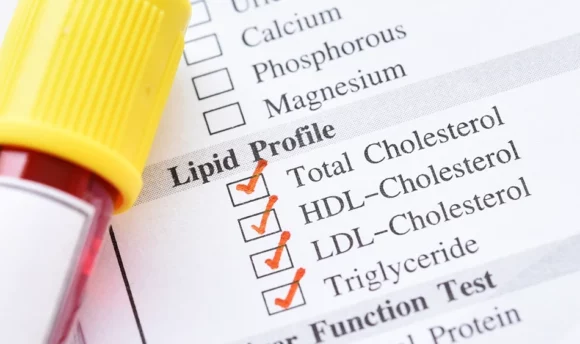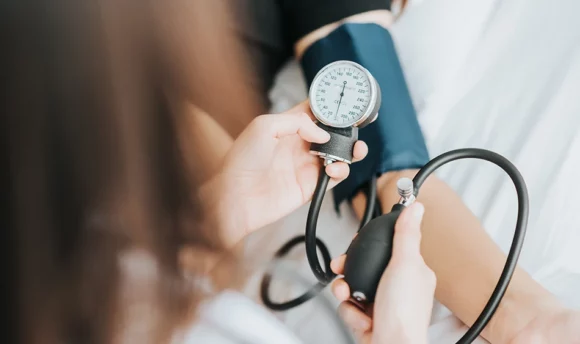How to Lower Diastolic Blood Pressure
High diastolic blood pressure is a condition that can lead to heart damage or heart attacks. This article discusses the symptoms and effective treatment strategies for lowering diastolic blood pressure.

Hypertension (high blood pressure) is a “silent killer” as it is a primarily symptomless condition that quietly destroys blood vessels causing severe health complications.
High blood pressure is one of the leading causes of death among adults in the US. Blood pressure measurements are recorded in millimeters of mercury. There are two measurements involved: systolic and diastolic blood pressure.
Blood pressure depends on the amount of blood the heart is pumping and the resistance of blood flow from the arteries. Our medical team at Health Reporter has outlined practical tips on how to lower diastolic blood pressure. Check out our detailed guide for more.
What Is Diastolic Blood Pressure?
Diastolic blood pressure refers to the force in your blood vessels when the heart is at rest. Systolic pressure, on the other hand, is the force exerted on your blood vessels when the heart is beating.
Blood pressure measurements contain the systolic and diastolic blood pressure. The systolic blood pressure is the upper number in the measurements, while the diastolic pressure is the lower.
According to an influential paper, most physicians focus on systolic blood pressure and ignore diastolic pressure. However, isolated diastolic hypotension is an increasing cause of heart failure among people over 40.
Healthy adults have a normal blood pressure reading of 120/80mmHg. Healthy adults have diastolic blood pressure readings of lower than 80 millimeters of mercury.
Elevated systolic blood pressure and high diastolic readings indicate high blood pressure.
Symptoms of high diastolic blood pressure
High diastolic blood pressure usually does not have warning symptoms. It might take years for the condition to worsen and symptoms to appear. Regular health checkups are the best way to know you have high diastolic pressure.
The common belief that sweating, blood spots in the eyes, facial flushing, and nervousness are symptoms of high blood pressure is a myth. However, if you experience chest pain, speech problems, and breathing difficulties, they might be indicative of complications such as a heart attack or stroke.
In rare cases, high diastolic pressure is characterized by nose bleeding and high blood pressure. If you experience this and are unwell, it is best to contact your doctor, as these symptoms could indicate high diastolic pressure or other health conditions.
How to Lower Diastolic Blood Pressure: 8 Easy Tips
It is impossible to lower diastolic blood pressure alone. You will have to lower your overall blood pressure when you have elevated diastolic pressure.
Fortunately, there are practical tips you can employ to significantly reduce blood pressure without having to use blood pressure medications. Below are some ways to lower your blood pressure and, consequently, diastolic pressure.
#1 Eat heart-healthy foods
A healthy diet rich in fruits, vegetables, whole grains, and low-fat dairy can help considerably lower your blood pressure. It is best to avoid a diet rich in sugar and refined carbs since it will raise blood pressure. You can also incorporate protein-rich foods such as eggs, nuts, and tofu into your diet.
Eating heart-healthy foods helps control high blood pressure and bring your cholesterol down to manageable levels.
#2 Cut back on caffeine
Experts suggest that chronic caffeine consumption can increase systolic blood pressure by 2.4mmHg and diastolic pressure by 1.2mmHg. However, some people do not experience increased blood pressure with caffeine consumption.
Caffeine consumption increases blood pressure due to its vasoconstrictive effects, whereby the arteries briefly become narrow. Most people have blood pressure spikes 30 minutes after consuming a caffeinated beverage.
It also causes high blood pressure (BP) since it triggers adrenal glands to secrete adrenaline that causes the heart to beat faster. Therefore, minimizing caffeine consumption is best to lower blood pressure.
Take measurements to see caffeine’s effects on your blood pressure. If it causes high blood pressure levels, consult a medical doctor for advice.
#3 Avoid alcohol
Excessive alcohol consumption raises your BP to unhealthy levels. Alcohol leads to an increase in renin levels, a hormone that makes blood vessels constrict. It also increases the calcium that binds to the blood vessels, which increases the sensitivity of blood vessels to compounds that make them constrict.
It also makes the body hold on to more water, typically limiting the amount of urine the kidneys produce. By affecting urine production, it causes dehydration and increases BP levels.
Alcohol also potentially increases blood cortisol levels, the hormone responsible for the body’s stress response. High cortisol levels affect normal body functioning and lead to increased BP levels.
Consuming more than three drinks in a sitting can temporarily lead to high blood pressure levels, but long-term binge drinking leads to long-term BP complications. Binge drinking refers to consuming four or more drinks in two hours for women and five or more within two hours for men.
Lifestyle changes such as limiting alcohol consumption, therefore, help lower blood pressure and aid one in avoiding numerous adverse health effects.
#4 Reduce sugar and sodium in your diet
Increased sodium intake affects the kidney’s ability to remove excess water from the blood leading to increased blood pressure. People should keep their salt intake at 2g a day to avoid increased blood pressure.
A systemic review showed that sugars, especially fructose, increase blood pressure more than salt. It showed that eating a low-carb, low-fat diet helps control high blood pressure by lowering the diastolic pressure by about 5mmHg after six months.
Incorporating more potassium than sodium in your daily diet also helps lower your blood pressure. Eating more potassium helps counteract the effects of sodium in the body. A high potassium diet also helps reduce blood pressure by lowering tension in the blood vessels.
Limiting salt and sugar consumption in your diet also helps one lose weight and lowers the risk of developing heart disease, heart failure, and high blood pressure.
#5 Try losing weight
Being obese or overweight increases the strain on heart muscle leading to a rise in blood pressure levels. Experts recommend that people maintain a Body Mass Index of 18.5 to 24.9. If you have a very high BMI reading, it is best to take measures to lose weight.
Excess body fat also puts one at a higher risk of having high blood pressure. Losing 10 pounds for overweight people can significantly lower the strain on the heart.
A collection of review studies shows that weight-loss diets and exercise can lower diastolic blood pressure by up to 3.2mmHg and systolic blood pressure by up to 4.5mmHg. Weight loss is a good treatment plan to ensure blood pressure stays healthy.
#6 Exercise frequently
Increased physical activity significantly lowers blood pressure. A study on sedentary adults showed that they managed to lower their diastolic pressure by 4.5% and systolic pressure by 3.9% after participating in aerobic exercises such as pilates.
Regular workouts and deep breathing exercises increase your breathing and heart rates, making it easier for your heart to pump blood with less effort. It also exerts less pressure on your blood vessels, lowering your blood pressure levels.
Ideally, you should have at least 150 minutes of moderately-intense exercise weekly. You can divide it into 3–4 sessions a week. You don’t need to spend grueling hours in the gym, but increasing your physical activity levels can be as simple as biking, walking, or gardening.
You can also incorporate other exercises like high-intensity interval training (HIIT), aerobic exercises, or resistance training like push-ups.
#7 Try to reduce stress
Stress increases the hormone cortisol production, making it difficult to maintain a healthy weight. Cortisol increases your sugar cravings and lowers the body’s metabolism, making weight loss difficult.
Stress also causes unhealthy eating habits such as starvation, emotional eating, skipping meals, and fast food. It also disrupts sleep patterns.
You can reduce stress cycles by making exercising a priority, eating healthy comfort foods, drinking more water, and incorporating stress relief strategies such as deep breathing and yoga in your daily routine.
Managing stress lowers your cortisol levels, which helps in weight management. If stress symptoms persist, it may be best to visit a psychotherapist for professional health advice.
#8 Monitor blood pressure
Measuring your blood pressure regularly is best to help keep it in check. Most people with high blood pressure are advised to self-monitor and check whether their blood pressure levels stay below 130/80mmHg.
The diastolic reading ranges between 60mmHg to 80mmHg, and too low diastolic blood pressure may lead to heart damage or heart disease. Too high levels are also indicative of cardiovascular disease.
Your doctor may, however, give you target blood pressure levels. If your blood pressure levels spike above the recommended levels, it is best to consult your doctor for medical advice.
What Causes High Diastolic Blood Pressure?
Elevated diastolic pressure normally occurs when one has hypertension and high systolic and diastolic numbers.
However, in rare cases, people experience isolated diastolic hypertension (IDH). This is when you have normal systolic blood pressure but a diastolic reading above 90mmHg.
Common causes of IDH are hormonal imbalance, sleep disorders, and endocrine and renovascular disorders. Some preventable causes include poor dietary habits, drinking excess alcohol, and increased stress levels.
Other uncontrollable risk factors of IDH include age, family history, previous cardiovascular episodes, kidney disease, diabetes, and hyperthyroidism.
The best way to lower diastolic pressure is by adopting lifestyle changes such as regular exercising such as running or cycling and improving dietary habits. If the high diastolic pressure persists, seek medical advice.
What to Eat for High Blood Pressure
To control blood pressure, eating foods low in carbs, added sugars, calories, and salt is best. It is also best to limit saturated and trans fats in your diet. Avoid fatty meats, a high sodium diet, canned foods, junk and fried foods, and salted snacks. It is also best to minimize alcohol intake.
The best foods you can incorporate into your diet include low-fat dairy products, lean meats such as skinless chicken, fresh fruits and vegetables, and low grains.
A nutritious, healthier diet lowers the strain on your heart and blood vessels, reducing your overall blood pressure levels.
FAQs
The bottom number in blood pressure measurements is the diastolic blood pressure. It measures the pressure exerted on blood vessel walls between beats when the heart is resting. The normal diastolic blood pressure readings range between 60mmHg and 80mmHg.
A high diastolic means one is at an elevated risk of heart attacks, heart disease, arterial disease, or other cardiovascular complications. Blood pressure readings above 80mmHg indicate one has high diastolic pressure.
Dietary changes and exercise take one to three months to lower blood pressure. With medication, you can lower your blood pressure in a few days, but it is not recommended as it may have some adverse side effects.
A Word From Our MD
There are numerous ways to lower your diastolic pressure readings. However, it’s important to note that you cannot lower the diastolic pressure alone, but you need to lower your blood pressure measurements.
Among the ways to lower your blood pressure are blood pressure medications, regular exercise, following a dash eating plan, and maintaining a healthy weight. It is best to stick to a proper dosage when using blood pressure medications to minimize health effects.
If you already have hypertension, you will most likely need a multi-pronged approach to check your blood pressure levels.
There is no quick fix to lower diastolic blood pressure, and it takes patience to reach manageable levels. It is, therefore, best to visit the doctor’s office to discuss the best treatment plan.
Conclusion
The diastolic blood pressure is the bottom blood pressure measurement. People with IDH have high diastolic pressure, which exposes them to an increased risk of having cardiovascular diseases.
It is best to go for regular blood pressure screenings and talk to your doctor early for advice about health risks you might be facing.

















































 Select your language:
Select your language: 








